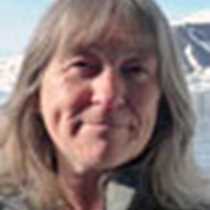Isles of Skye and Canna, Scotland
This morning, in the peace and tranquility of a Hebridean Sabbath, we went ashore to explore the remote and beautiful area around Boreraig on the southern aspect of Skye. On disembarking from the Zodiacs we were immediately fascinated to find ourselves walking over rocks rich in fossils. These included an ammonite of large proportions (see photo) and deep bands packed with Gryphaea sp. Above the shoreline are scattered the poignant remains of the homes once occupied by the tenant crofters of Boreraig and their families. They were cleared off the land in 1851 by the landowner Lord Macdonald at the time of the Highland Clearances, to make way for a more profitable sheep farm. Each homestead consists of a drystone cottage of two or three rooms and an outbuilding or two, all within a stone-built enclosure. These stand as a reminder of how this empty and deserted glen was once a bustling community of 300 people, as so many now desolate places in the Scottish Highlands.
These were virtually the last of many people who occupied this fertile corner, as an ancient burial cairn and standing stone testify. The remains of a headland fort, or dun, with commanding views to all sides has stood guard over the community of Boreraig for up to 2000 years. One of our hiking parties, while looking for this dun, discovered an apparently unknown Iron Age round house close to the shore. Another group walked uphill amongst swathes of yellow irises, for spectacular views of the Black Cuilin mountains, to the echo of the cuckoo’s call.
Then it was back to the Endeavour for a Swedish lunch and a warming glass of schnapps. The afternoon was devoted to visiting the lovely island of Canna, owned and cared for by the National Trust for Scotland. Despite having a resident population of about 13, Canna maintains two small, exquisite churches. A third, disused church on the connected island of Sanday is currently being converted to house a library of Gaelic literature, folklore and songs collected by the island’s previous owner, John Lorne Campbell. While golden eagles wheeled high overhead, some of us strolled off the track to see an early sculptured high cross, set apart in a meadow golden with field buttercups. Towards the western shores of Sanday, where now only oystercatchers are heard, we found the remains of kelp kilns where islanders at one time burnt seaweed to produce potash, one of the few places where evidence of this once widespread industry can still be seen. Our departure from Canna in late afternoon sunshine was watched languidly by the grey seals.
This morning, in the peace and tranquility of a Hebridean Sabbath, we went ashore to explore the remote and beautiful area around Boreraig on the southern aspect of Skye. On disembarking from the Zodiacs we were immediately fascinated to find ourselves walking over rocks rich in fossils. These included an ammonite of large proportions (see photo) and deep bands packed with Gryphaea sp. Above the shoreline are scattered the poignant remains of the homes once occupied by the tenant crofters of Boreraig and their families. They were cleared off the land in 1851 by the landowner Lord Macdonald at the time of the Highland Clearances, to make way for a more profitable sheep farm. Each homestead consists of a drystone cottage of two or three rooms and an outbuilding or two, all within a stone-built enclosure. These stand as a reminder of how this empty and deserted glen was once a bustling community of 300 people, as so many now desolate places in the Scottish Highlands.
These were virtually the last of many people who occupied this fertile corner, as an ancient burial cairn and standing stone testify. The remains of a headland fort, or dun, with commanding views to all sides has stood guard over the community of Boreraig for up to 2000 years. One of our hiking parties, while looking for this dun, discovered an apparently unknown Iron Age round house close to the shore. Another group walked uphill amongst swathes of yellow irises, for spectacular views of the Black Cuilin mountains, to the echo of the cuckoo’s call.
Then it was back to the Endeavour for a Swedish lunch and a warming glass of schnapps. The afternoon was devoted to visiting the lovely island of Canna, owned and cared for by the National Trust for Scotland. Despite having a resident population of about 13, Canna maintains two small, exquisite churches. A third, disused church on the connected island of Sanday is currently being converted to house a library of Gaelic literature, folklore and songs collected by the island’s previous owner, John Lorne Campbell. While golden eagles wheeled high overhead, some of us strolled off the track to see an early sculptured high cross, set apart in a meadow golden with field buttercups. Towards the western shores of Sanday, where now only oystercatchers are heard, we found the remains of kelp kilns where islanders at one time burnt seaweed to produce potash, one of the few places where evidence of this once widespread industry can still be seen. Our departure from Canna in late afternoon sunshine was watched languidly by the grey seals.




